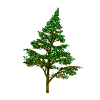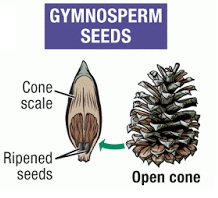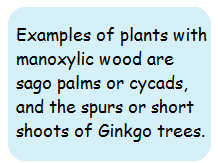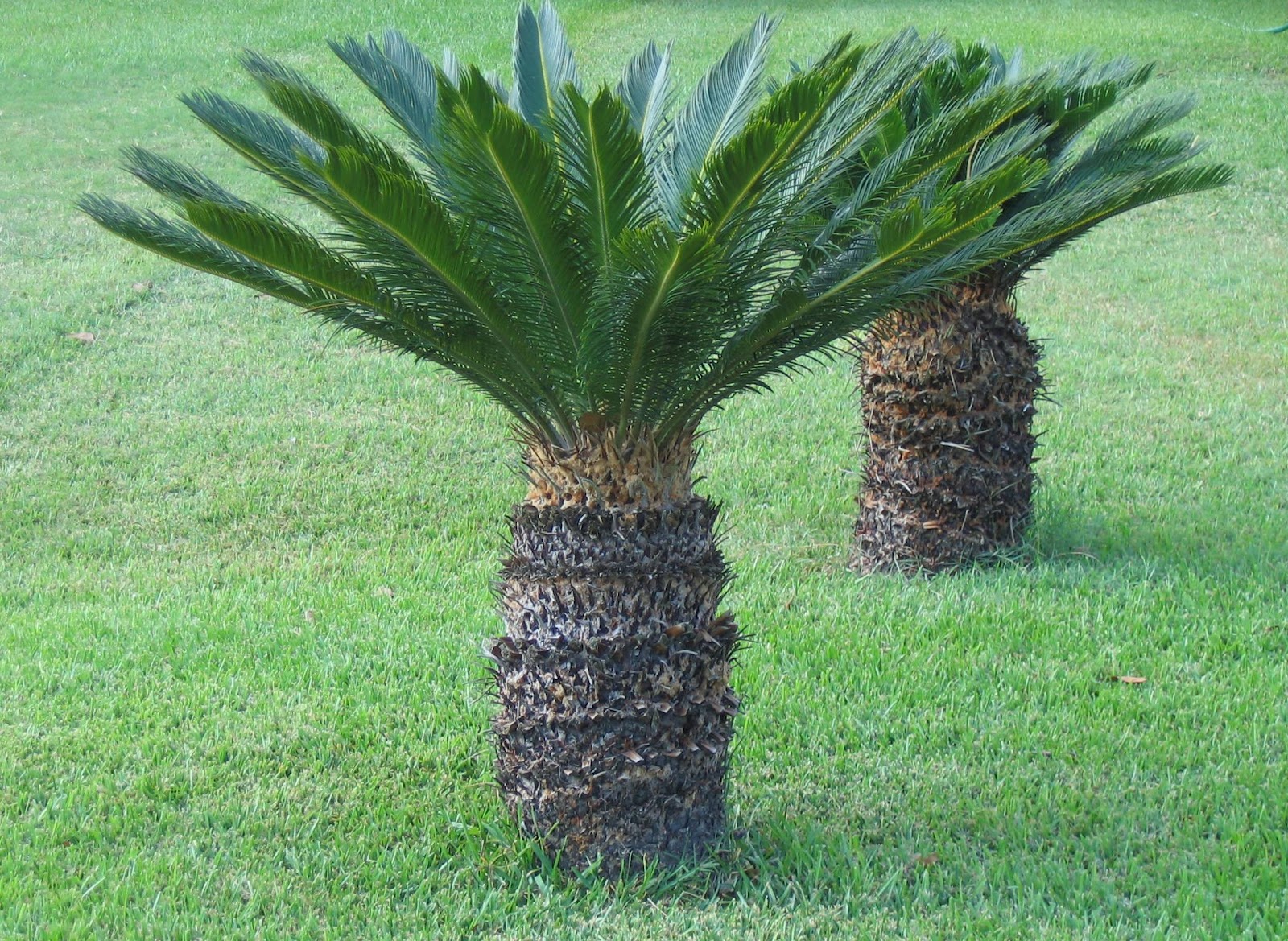Gymnosperms
Table of Content |

 - Gymnosperm (Gk. Gymnos = naked ; sperma = seed) are the plants with exposed or naked seeds or ovules.
- Gymnosperm (Gk. Gymnos = naked ; sperma = seed) are the plants with exposed or naked seeds or ovules.
- These plants represent the most ancient group of seed plants.
- They have been generally placed in the division spermatophyta (seed bearing plants) along with angiosperms. They were not grouped separately as gymnosperms. But Robert Brown (1827) separated them from angiosperms and placed under a distinct group due to presence of unprotected ovules in them.
- The gymnosperm originated much earlier than angiosperms. However, most of the members of this group have now become extinct and only few living forms are known today.
- The living gymnosperm are generally grouped under four orders (Cycadales, Ginkgoales, Coniferales and Gnetales).
- Gymnosperms include medium-sized trees or tall trees and shrubs.
- One of the gymnosperms, the giant redwood tree Sequoia is one of the tallest tree species.
Characteristics of Gymnosperms
-
The roots are generally tap roots.
-
Roots in some genera have fungal association in the form of mycorrhiza (Pinus), while in some others (Cycas) small specialised roots called coralloid roots are associated with N2- fixing cyanobacteria.

-
The stems are unbranched (Cycas) or branched (Pinus, Cedrus).
-
The leaves may be simple or compound. In Cycas the pinnate leaves persist for a few years.
-
The leaves in gymnosperms are well adapted to withstand extremes of temperature, humidity and wind.
-
In conifers, the needle-like leaves reduce the surface area. Their thick cuticle and sunken stomata also help to reduce water loss.
Reproduction
-
The gymnosperms are heterosporous; they produce haploid microspores and megaspores.
-
The two kinds of spores are produced within sporangia that are borne on sporophylls which are arranged spirally along an axis to form lax or compact strobili or cones.
-
The strobili bearing microsporophylls and microsporangia are called microsporangiate or male strobili.
Life Cycle of Gymnosperms
-
The microspores develop into a male gametophytic generation which is highly reduced and is confined to only a limited number of cells. This reduced gametophyte is called a pollen grain.
-
The development of pollen grains takes place within the microsporangia.
-
The cones bearing megasporophylls with ovules or megasporangia are called macrosporangiate or female strobili.
-
The male or female cones or strobili may be borne on the same tree (Pinus) or on different trees (Cycas).
-
The megaspore mother cell is differentiated from one of the cells of the nucellus.
-
The nucellus is protected by envelopes and the composite structure is called an ovule. The ovules are borne on megasporophylls which may be clustered to form the female cones.
-
The megaspore mother cell divides meiotically to form four megaspores.
-
One of the megaspores enclosed within the megasporangium (nucellus) develops into a multicellular female gametophyte that bears two or more archegonia or female sex organs.
-
The multicellular female gametophyte is also retained within megasporangium.
-
Unlike bryophytes and pteridophytes, in gymnosperms the male and the female gametophytes do not have an independent free-living existence.
-
They remain within the sporangia retained on the sporophytes.
-
The pollen grain is released from the microsporangium. They are carried in air currents and come in contact with the opening of the ovules borne on megasporophylls.
-
The pollen tube carrying the male gametes grow towards archegonia in the ovules and discharge their contents near the mouth of the archegonia.
-
Following fertilisation, zygote develops into an embryo and the ovules .into seeds. These seeds are not covered.

Gymnospermous Wood
-
Monoxylic wood: The wood formed may be in one ring due to persistent cambium. Such a wood is called as monoxylic e.g, Pinus.
-
Cambial activity is short lived, cortex and pith are broad, parenchymatous rays are broad, wood is soft and commercially useless. e.g., Cycas.
-
Pycnoxylic wood: The wood is formed in more than one ring due to ephimeral nature of cambium. Such a wood is called as polyxylic.
-
 Cambial activity is long lived, cortex and pith are reduced, parenchymatous rays are few, wood is hard and compact, wood is commercially most important and used as good quality timber. e.g., Pinus.
Cambial activity is long lived, cortex and pith are reduced, parenchymatous rays are few, wood is hard and compact, wood is commercially most important and used as good quality timber. e.g., Pinus. -
The wood of Cedrus deodara is used for making railway sleepers. It is also used as a structural timber and making bridges.
-
The wood of Callitris verrucosa, Pinus roxburghii, P. wallichiana, P. pinaster, P. lambertiana etc. is used for making furniture. Juniperus virginiana wood is used for making pencils.
-
The gymnosperm Agathis australis is perhaps the largest timber producing tree of the world.
Pinus
-
Pinus is an evergreen, perennial plant of xerophytic nature.
-
The whorled branching gives a typical conical or ex-current appearance to the plant (due to apical dominance).
-
The plant body is sporophyte and the plants ate monoecious.
-
The plant body is differentiated into roots, stem and leaves.
-
Pinus reproduces only by means of spores. Unlike Cycas, here the, micro and megasporophylls form compact male and female cone or strobilus respectively.
-
Pinus plant is sporophyte (2x), heterosporous (producing two type of spores - microspore and megaspore), monoecious (male and female cones are borne on same plant) and autoecious (male and female cones are borne on different branches).
Cycas
-
Cycas is an evergreen palm-like plant. It is the only genus of family Cycadaceae represented in India.

-
Cycas plants are dioecious and reproduce by following methods:
(1) Vegetative propagation: It occurs by means of bulbils (resting adventitious buds) which are produced on the stem in the axil of scale leaves. They break up from the parent plant and germinate to give rise to new plant.
(2) Sexual reproduction: Plant of Cycas is sporophyte (2n) and dioecious. The sexual reproduction is of oogamous type, i.e., takes place by the fusion of distinct male and female gametes.
-
The male and female gametes are formed by the germination of micro and megaspores which are born on microsporophylls and megasporophylls.
-
The microsporophylls are grouped together to form a compact conical structure called male cone, whereas the megasporophylls are not aggregated to form a cone, they are produced at the apex of the stem in succession with the leaves.


Question 1: Sporophyte is dependent on gametophyte in
(1) Bryophytes
(2) Gymnosperms
(3) Angiosperms
(4) Pteridophytes
Question 2: Among the following which one are non-vascular plants
(1) Pteridophytes
(2) Bryophytes
(3) Angiosperms
(4) Gymnosperms
Question 3: A plant having vascular supply, producing spores but lacking seeds is a –
(1) Bryophyte
(2) Pteridophyte
(3) Gymnosperm
(4) Angiosperm
Question 4: Which of the following plants exhibit independent alternation of generation?
(1) Angiosperms
(2) Gymnosperms
(3) Pteridophytes
(4) Bryophytes
Question 5: Neck canal cells are absent in archegonia of
(1) Bryophytes
(2) Gymnosperms
(3) Pteridophules


| Q.1 | Q.2 | Q.3 | Q.4 | Q.5 |
| 1 | 2 | 1 | 3 | 2 |
Related Resources
-
Click here to refer the Useful Books of Biology for NEET (AIPMT)
-
Click here for Study Material on Angiosperms
To read more, Buy study materials of Plant Kingdom comprising study notes, revision notes, video lectures, previous year solved questions etc. Also browse for more study materials on Biology here.



